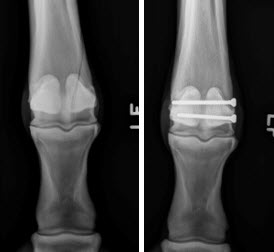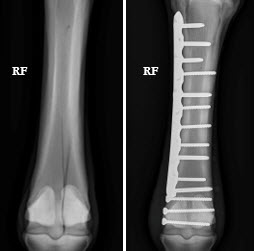A fracture, also known as a break in a bone, can occur in any bone of the horse. If you suspect your horse has a fracture, contact your primary care veterinarian immediately for evaluation and emergency first aid and stabilization. Prompt, appropriate initial care is crucial for successful outcomes in horses with fractures. Following evaluation and emergency first aid, it is important to consult with your veterinarian and an ACVS board-certified veterinary surgeon to determine if your horse is a candidate for fracture repair. In horses, some fractures can be managed conservatively without surgery, many fractures can be repaired surgically, and some cannot be surgically repaired. If the fracture can be surgically repaired, your horse should be transported to a surgical facility, following stabilization of the fracture by your veterinarian, for repair by an ACVS board-certified veterinary surgeon.
Not bearing any weight on the limb or severe lameness (i.e. toe-touching, dragging the limb, hopping). Signs of pain/shock (e.g. elevated heart rate, elevated respiratory rate, sweating, anxiousness):
- Abnormal contour, angle, or shape of the limb, face, or ribs
- Swelling around the fractured area
- Bleeding if there is a wound or laceration associated with the fracture area
If you suspect your horse has a fracture, call your veterinarian immediately. For more information on emergency first aid and stabilization of fractures in the horse please refer to the animal health topic: Fractures in Horses – Emergency First Aid and Stabilization.
Your veterinarian may take initial radiographs in the field (depending on the suspected fracture location) and then place a bandage with a splint or a cast for transportation to the surgical facility. Once your horse is at the surgical facility, the surgeon will evaluate your horse and repeat radiographs. This is to ensure the fracture has not changed following transportation and for surgical planning. Further, advanced imaging such as ultrasound or computed tomography (CT) may also be performed.
Following diagnostics, an ACVS board-certified veterinary surgeon will determine whether your horse is a candidate for fracture repair and will discuss options for treatment with you. The main factors that will be considered are:
- Location of the fracture
Size of the horse
Open versus closed fracture
Severity of the fracture
Condition and temperament of the horse
Cost of treatment
Expectations for outcome (i.e., return to full use versus pasture sound)
In horses, many fractures can be repaired surgically, however unfortunately some cannot be surgically repaired. The location and severity of the fracture will highly influence the options for surgical repair. A variety of surgical repair techniques have been developed and used in horses. These techniques are often performed with the horse placed under general anesthesia, though some can be performed with the horse sedated and standing. Simple fractures may only require a few metallic screws or wires to stabilize the fracture (Figure1) while other, more complex fractures may require multiple metallic plates and screws (Figure 2).


Horses placed under general anesthesia must stand to their feet following fracture repair. This process can stress the surgical repair and in rare cases will lead to disruption of the repair or breakage of the implants. Most surgical facilities will recover horses with ropes placed on their halter and tail to make the recovery process easier and to decrease the risk of these complications. A few surgical facilities have a pool-raft recovery system that horses are placed into for recovery.
Following fracture repair, your horse will initially be confined to a stall and may be required to wear a cast or bandage with or without a splint for a period of time. The length of the rest and rehabilitation will depend on the type of fracture and the repair but generally lasts 3-6 months. Horses that undergo fracture repair are also typically treated with antimicrobials and anti-inflammatories for a period of time after surgery.
Post-operative fracture repairs can suffer from complications, similar to other types of surgery. These can include surgical site infection, laminitis (i.e. founder), and failure of the implant or repair. A surgical site infection in these cases can be more challenging to treat due to the metallic implant. The implant can serve as a site for bacteria to collect and may require implant removal once the fracture has healed. ACVS board-certified veterinary surgeons are trained to utilize current therapies to minimize the risk of post-operative complications, however, there is always risk involved in fracture repair.
Surgical success rates have improved over the years due to prompt appropriate first aid, early referral, and surgical intervention, however prognosis depends on a variety of factors, including those listed above.













